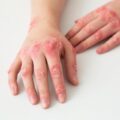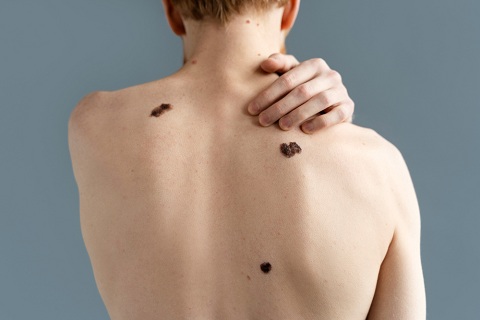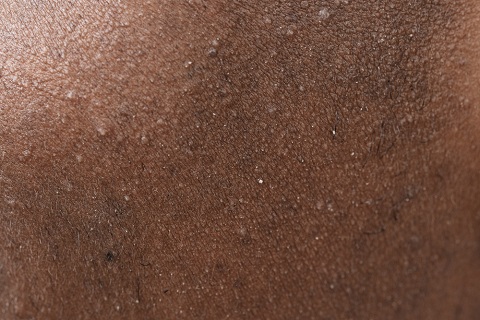Tinea pedis, commonly known as athlete’s foot, is a fungal infection that affects the skin on the feet. It’s a prevalent condition, especially among athletes and individuals who frequently wear tight-fitting shoes or have sweaty feet.
These fungi thrive in warm, moist environments such as sweaty socks and shoes. They can also spread through direct contact with an infected person or contaminated surfaces.
Causetion of Tinea Pedis
Commonest organism causing Tinea Pedis is Trichopyton rubram. Tinea pedis is a contagious fungal infection caused primarily by dermatophyte fungi. In chronic tinea pedis, resident bacteria like large-colony coryneforms can act as important copathogens.
Soft corns or callosities sometimes with sinus formation are common in the lateral toe clefts, especially in women.
In cases where the soles of the feet, especillay the heels, are involved more than the toe cleft, pustular psoriasis must be ruled out.
Symptoms of Tinea Pedis
Itching and Burning
One of the most common symptoms of tinea pedis is persistent itching and burning sensation on the affected areas, typically between the toes.
Redness and Inflammation
Infected skin often appears red, swollen, and inflamed. The affected areas may also develop small blisters or vesicles filled with fluid.
Blisters and Cracking
As the infection progresses, blisters may rupture, leading to raw, cracked skin that is vulnerable to secondary bacterial infections.
Diagnosis
Diagnosing tinea pedis usually involves a physical examination of the affected skin. In some cases, your doctor may take a skin scraping for laboratory analysis to confirm the presence of fungal infection.
Candidosis is differetiated from tinea pedis due to build-up of rather more white macerated skin.
Prevention
Proper Foot Hygiene
Maintaining good foot hygiene, including washing feet daily with soap and water and thoroughly drying them afterward, can help prevent tinea pedis.
Wearing Breathable Footwear
Wearing breathable footwear made of natural materials such as cotton or leather can reduce the risk of fungal infections by allowing air circulation around the feet.
Avoiding Sharing Personal Items
Avoid sharing towels, socks, shoes, or other personal items with others to minimize the risk of spreading fungal infections like tinea pedis.
Complications
Secondary Bacterial Infections
Scratching the infected skin can lead to open wounds, increasing the risk of secondary bacterial infections such as cellulitis.
Recurrence
Without proper treatment and preventive measures, tinea pedis can recur, especially in individuals prone to fungal infections or those with compromised immune systems. The infection tends to spread from use of a common family bathroom or pool.
Impact on Daily Life
Discomfort and Inconvenience
The symptoms of tinea pedis can cause significant discomfort and inconvenience, affecting daily activities such as walking and exercising. Once hesitates to enter an enclosed room, because an offensive odor of the part.
Psychological Effects
Chronic tinea pedis may have psychological effects, including embarrassment or self-consciousness due to the appearance and excessive perspiration with odor of the affected feet. The vesicles become pustules, which then rupture and leave collarettes of scaling with normal intervening skin or there can be various degrees of scaling and inflammation.
When to See a Doctor
Persistent Symptoms
If symptoms of tinea pedis persist despite home treatment or worsen over time, it’s essential to consult a healthcare professional for proper diagnosis and management.
Complications Arise
Seek medical attention if you develop signs of secondary bacterial infection, such as increased pain, swelling, severe odor or drainage from the affected area.
FAQs about Tenia Pedis
With proper treatment, tinea pedis can typically be effectively treated and resolved. However, without treatment, the infection may persist and even worsen over time.
Tinea is a general term used to describe fungal infections caused by dermatophyte fungi, whereas athlete’s foot specifically refers to a type of tinea infection that affects the skin on the feet, particularly between the toes.
Some natural remedies that may help kill foot fungus include tea tree oil, vinegar, garlic, and coconut oil. However, it’s essential to consult a healthcare professional for proper diagnosis and treatment, as natural remedies may not always be effective on their own.
The duration of tinea infections can vary depending on factors such as the severity of the infection, the effectiveness of treatment, and individual differences in immune response. Mild cases of tinea pedis may resolve within a few weeks with proper treatment, while more severe or recurrent infections may take longer to heal.
If left untreated, tinea infections can persist and spread to other areas of the body, leading to complications such as secondary bacterial infections, cellulitis, or chronic inflammation. It’s essential to seek medical attention if you suspect you have tinea or if symptoms persist despite home treatment.
While tinea infections are generally not considered harmful in themselves, untreated infections can lead to discomfort, inconvenience, and complications such as secondary bacterial infections. It’s essential to seek proper treatment to prevent complications and promote healing.
To prevent tinea infections from spreading, it’s essential to practice good foot hygiene, including washing and thoroughly drying the feet daily, wearing clean socks and breathable footwear, avoiding sharing personal items such as towels or shoes, and seeking prompt treatment for any suspected fungal infections. Additionally, keeping the skin clean and dry, especially in areas prone to sweating, can help reduce the risk of fungal growth and spread.
Conclusion
Tinea pedis, or athlete’s foot, is a common fungal infection that affects the skin on the feet. With proper treatment and preventive measures, it’s possible to manage symptoms effectively and reduce the risk of recurrence.





